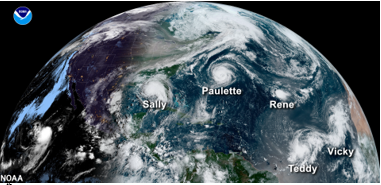The internationally agreed Declaration of the Small Island Developing States (SIDS) Accelerated Modalities of Action, the so-called S.A.M.O.A Pathway, recognizes that SIDS remain a special case for sustainable development in view of their unique and particular vulnerabilities. Due to their specific common development challenges, SIDS are on the frontline of the multiple climate and nature crises which are now being amplified by the global COVID-19 pandemic and subsequent economic shutdown. All the ingredients for a “perfect storm” had been in play in SIDS in 2020 and most still remain active in 2021.
Global decline in international travels, in commodity prices as well as the overall disruptions in worldwide trade and supply chains directly resulting from the pandemic are hitting SIDS disproportionately in a multitude of sectors: health system, tourism revenues, remittance flows, food security, commodities, trade as well as the existing debt situation. With tourism representing 80 per cent of total export revenues in SIDS, globally, exceptional reduction in this sector due to the pandemic severely decreased external income in SIDS ("Financing for Sustainable Development", UNDESA, 2021). Data on tourism arrivals for the second quarter of 2020 in the Pacific Islands for example, shows that the arrival number had dropped by 99.3% as compared to 2019 for the same period (Secretariat of Pacific Community, 8 December 2020). Also, the escalating debt service (median debt service is of about 30 per cent of revenue in SIDS) is rerouting public expenditure and foreign currency from the COVID-19 recovery, and from investments in resilience. Furthermore, recent studies show that SIDS with higher GNI per capita levels are not more resilient to face the present crisis (“Mapping the Economic Consequences of Covid-19 in Small Island Developing States” OECD, 2020).

tropical systems (2 Hurricanes and 3 Tropical storms) in
the Atlantic Ocean at the same time. September 2020
experienced the formation of a total of 10 named storms –
the highest number for any month on record according to NOAA.
In addition to this unprecedented health crisis, 2020 was also a record-breaking Atlantic hurricane season according to the U.S. National Oceanic and Atmospheric Administration. Indeed, with a total of 30 active tropical storms, 2020 surpassed the year 2005 which recorded the second-greatest number of hurricanes (28). This trend is also confirmed in the Pacific region which has experienced the most destructive cyclones on record in its territory. Tropical Cyclone category 5 Yasa in December 2020 for example was the second-strongest cyclone on record to make landfall in Fiji.
The 38 SIDS represent over 30% of countries with the highest relative annual losses due to disasters (OECD 2016). According to the World Bank, annual damages to infrastructure from natural disasters in the Caribbean region are estimated at US$0.5-1 billion/year. In the Pacific Islands, the value of infrastructure and cash crops at risk from natural disasters are estimated at US$112 billion (World Bank, 2013). The 2019 Global Assessment Report on Disaster Risk Reduction points out that while Jamaica’s economy has grown up to 0.8% annually over the past 4 decades, it would have grown by about 4% without the economic losses and damage cause by tropical cyclones. Some other examples: In 2015, cyclone Pam impacted Vanuatu with 449.4 million USD reported in losses for an economy with a GDP of 758 million USD (Post-Disaster Needs Assessment in Vanuatu 2015); In 2016, cyclone Winston resulted in losses of more than one third of Fiji GDP (Government of Fiji, 2016); In 2017, hurricane Maria caused total damages estimated at 226% of Dominica GDP (Post-Disaster Needs Assessment for Dominica, 2017); In 2018, cyclone Gita hit Tonga and resulted in 165 million USD of losses for a national GDP of 461 million USD (Government of Tonga, 2018). For SIDS, due to their small geographic size and small economies, what were one-off events with contained impacts are now having significant systemic implications across sectors with lasting macro-economic impacts.
Such devastating trajectory for SIDS is set to continue in the years to come as climate change is making these disasters more frequent and intense. The 2019 IPCC Special Report on the Ocean underlines that low-lying geologies, narrow ecological conditions, climate sensitive ecosystems, as well as growing anthropogenic pressures are disproportionately putting SIDS in higher risks regarding hydrometeorological disasters for instance. With more than 80% of small island residents living near the coast, the rise of sea level combined with storm surges, tides and waves for example is of extreme concern. In Tuvalu, the length of the coastline compared to the landmass is one of highest ratio in the world. Disaster losses are not only severely threatening the achievement of the SDGs but represent an existential threat for many SIDS.
Download the full article by clicking here.